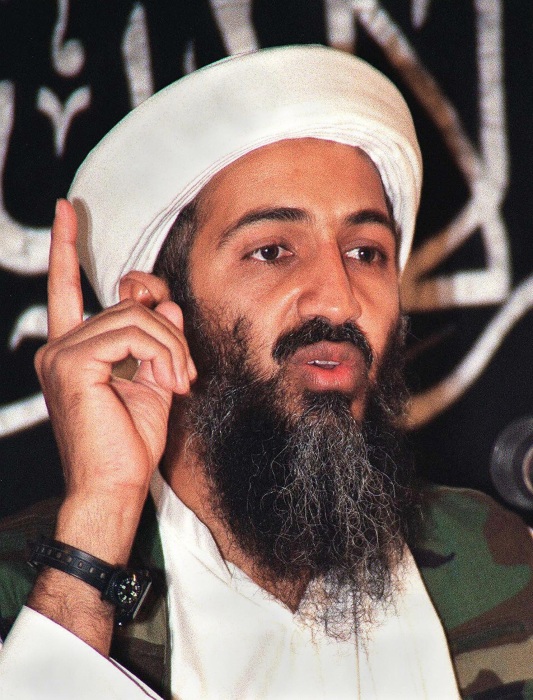WASHINGTON — A document seized the night Navy SEALs killed Osama Bin Laden suggests that Al Qaeda and Iran had a relationship more complicated and intimate than previously known — one that included threats and kidnappings, but also occasional cooperation.
The document was among a massive trove of material released Wednesday by the CIA following a request by the Long War Journal, a website that has chronicled the U.S. war on terrorism. The site received a copy of the materials Tuesday.
The U.S. government released hundreds of thousands of files in the aftermath of the May 1, 2011 raid on Bin Laden's Pakistan compound, and released other tranches in 2015 and 2016.
Wednesday's release included nearly 470,000 more files recovered in the raid. Most of the newly disclosed material is in Arabic, untranslated, and uncurated. It includes Bin Laden's untranslated 228-page private journal, and other documents that officials say support a U.S. intelligence estimate produced just after the raid that bin Laden continued to act as an operational commander of Al Qaeda even in the months just before his death.
According to the CIA, "the materials provide insights into the origins of fissures that exist today between Al Qaeda and ISIS; as well as strategic, doctrinal and religious disagreements within Al Qaeda and its allies; and hardships that Al Qaeda faced at the time of Bin Laden's death."

The trove also provides new insight into the often adversarial relationship between al Qaeda and Iran — the Sunni Muslim terror group and the Shiite republic — in the form of a 19-page report described by the Long War Journal as "a senior jihadist's assessment of the group's relationship with Iran."
Two U.S. intelligence officials characterized the document to NBC News as "evidence of Iran's support of al Qaeda's war with the United States."
According to the officials, the document traces the history of the relationship starting with the escape of a group of Al Qaeda officials and their families from Afghanistan following the U.S. invasion in September 2001. Bin Laden dispatched the group of Al Qaeda leaders, known as the Al Qaeda Management Council, to Iran.
At various points in the relationship, the document reveals, Iran offered Al Qaeda help, in the form of "money, arms" and "training in Hezbollah camps in Lebanon, in exchange for striking American interests in Saudi Arabia and the Gulf."
But at other points in the relationship, according to the document, there were angry rifts, leading to forced detention of key Al Qaeda officials.

The files confirm previous reports that Bin Laden wrote Iran's Ayatollah Khamenei demanding the release of family members held in Iranian custody. Bin Laden himself considered plans to counter Iran's influence throughout the Middle East, which he viewed as pernicious, according to the Long War Journal, an account confirmed by the U.S. officials.
Previous reports indicated that at one point Bin Laden ordered the kidnapping of an Iranian diplomat to trade for one of Al Qaeda's top commanders, which the document confirms.
Iran has vigorously denied that it cooperated with Al Qaeda, stating that it kept the members of the Management Council in jails, not under house arrest.
Among the materials are approximately 79,000 audio and image files and more than 10,000 video files, which include Al Qaeda "home videos," draft videos or statements by Bin Laden, and jihadist propaganda.
The videos include footage of Bin Laden's son Hamza's wedding, which reportedly took place in Iran. Hamza, now in his 20's, is increasingly seen as his father's successor as head of Al Qaeda.
Bin Laden also apparently downloaded a 2005 MSNBC interview of former CIA Director James Woolsey by Alex Witt that focused on the Iraq War. His collection of videos included a jihadist beheading video and a recruiting video featuring Iraqi Al Qaeda leader Abu Musab al-Zarqawi, who was killed in a 2006 U.S. airstrike.
But the videos also include many that seem more designed to alleviate boredom than to promote jihad, and reveal a weakness for slapstick humor. Found on Bin Laden's computer were episodes of "America's Funniest Home Videos," the cartoon "Tom and Jerry," and several viral videos, including "Charlie Bit My Finger" — a YouTube staple from 2007 featuring a kid biting his brother that was once the most viewed YouTube video of all time.
There were also a couple of "Trunk Monkey" commercials from an Oregon car dealer in which a monkey emerges from a car's trunk to save imperiled drivers, plus instructional videos on crocheting, teaching videos for counting and the English alphabet and a slew of home videos showing animals in the Bin Laden compound. Several wives and a number of small children lived with Bin Laden in his compound.




No comments:
Post a Comment